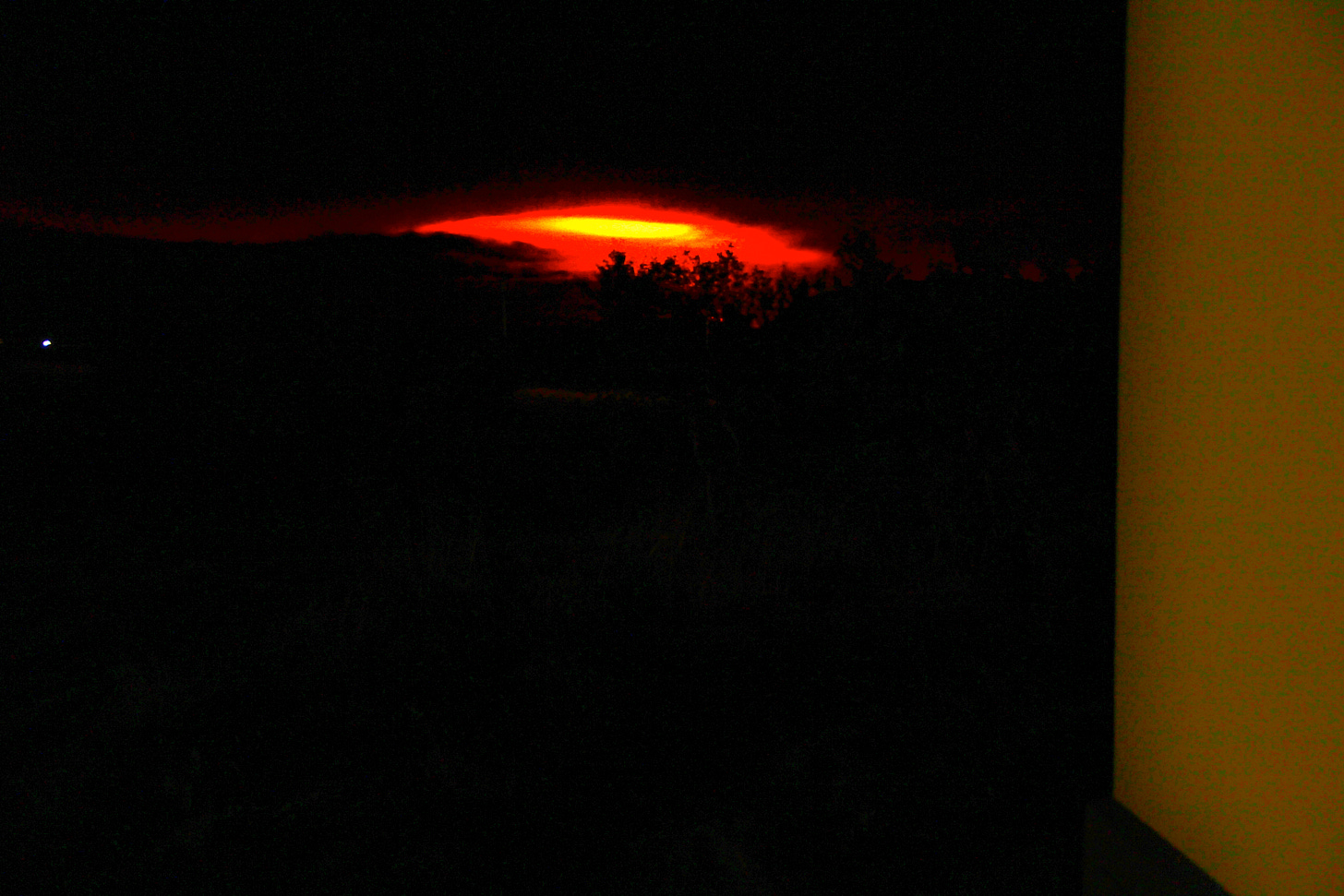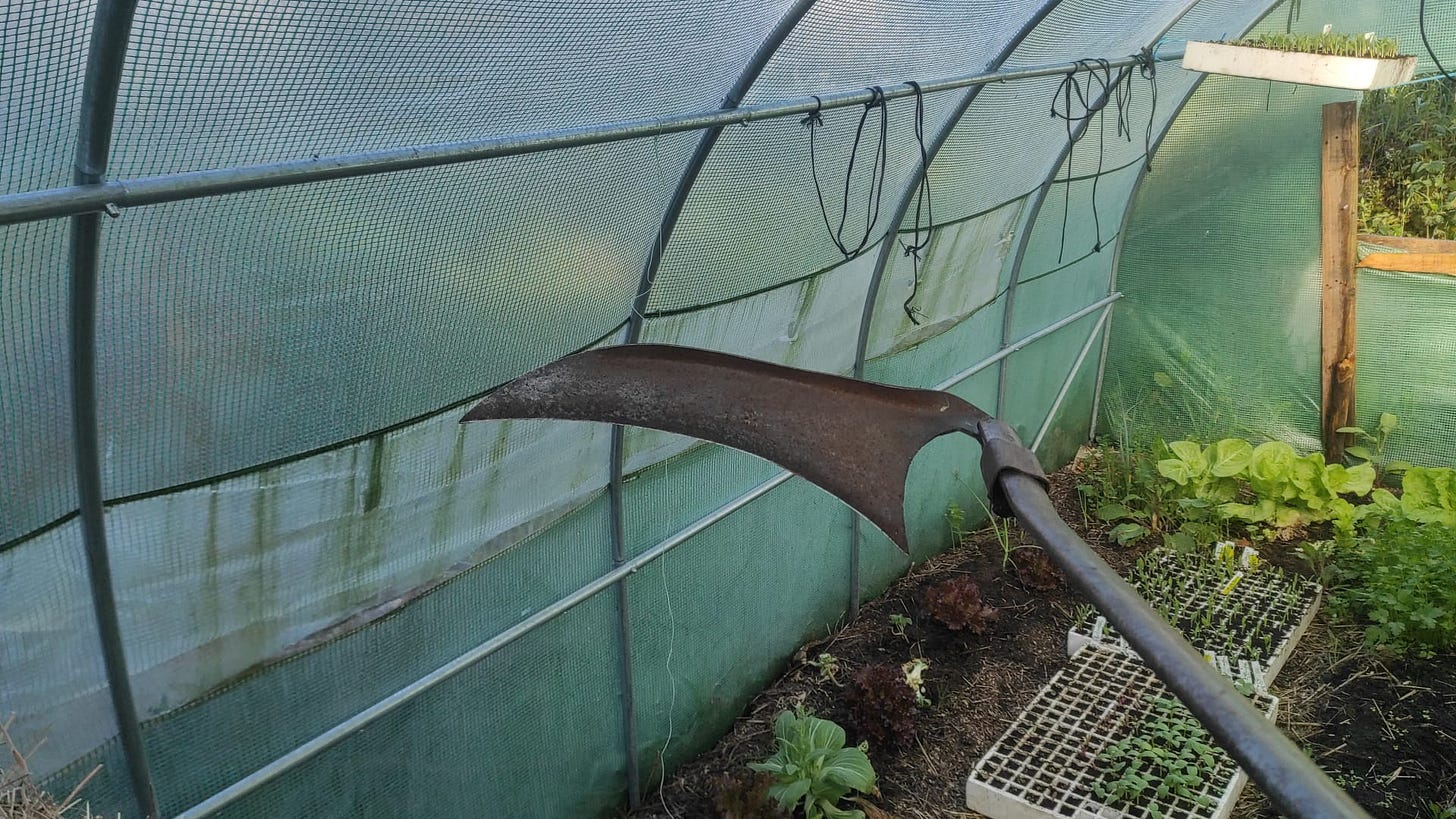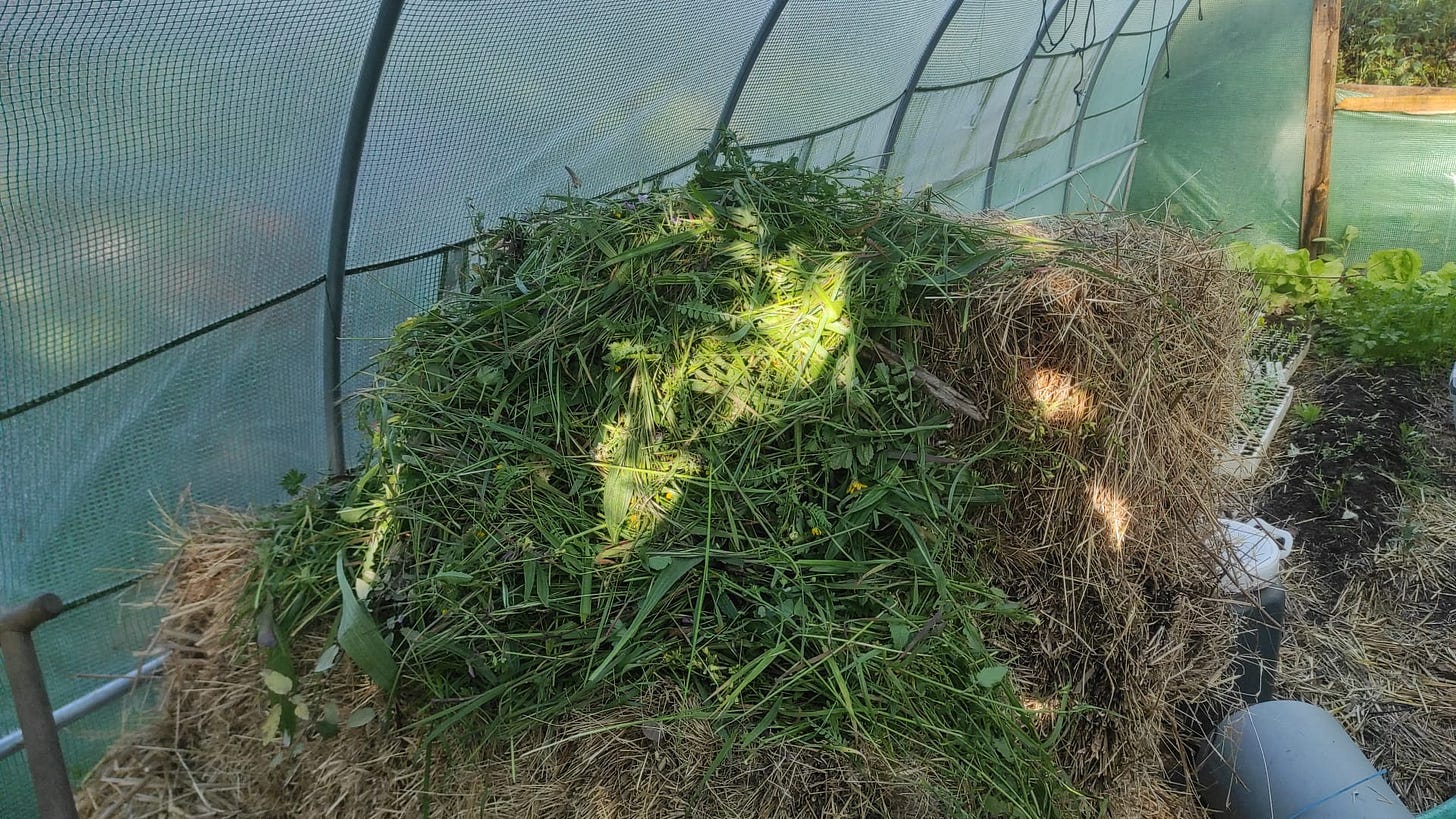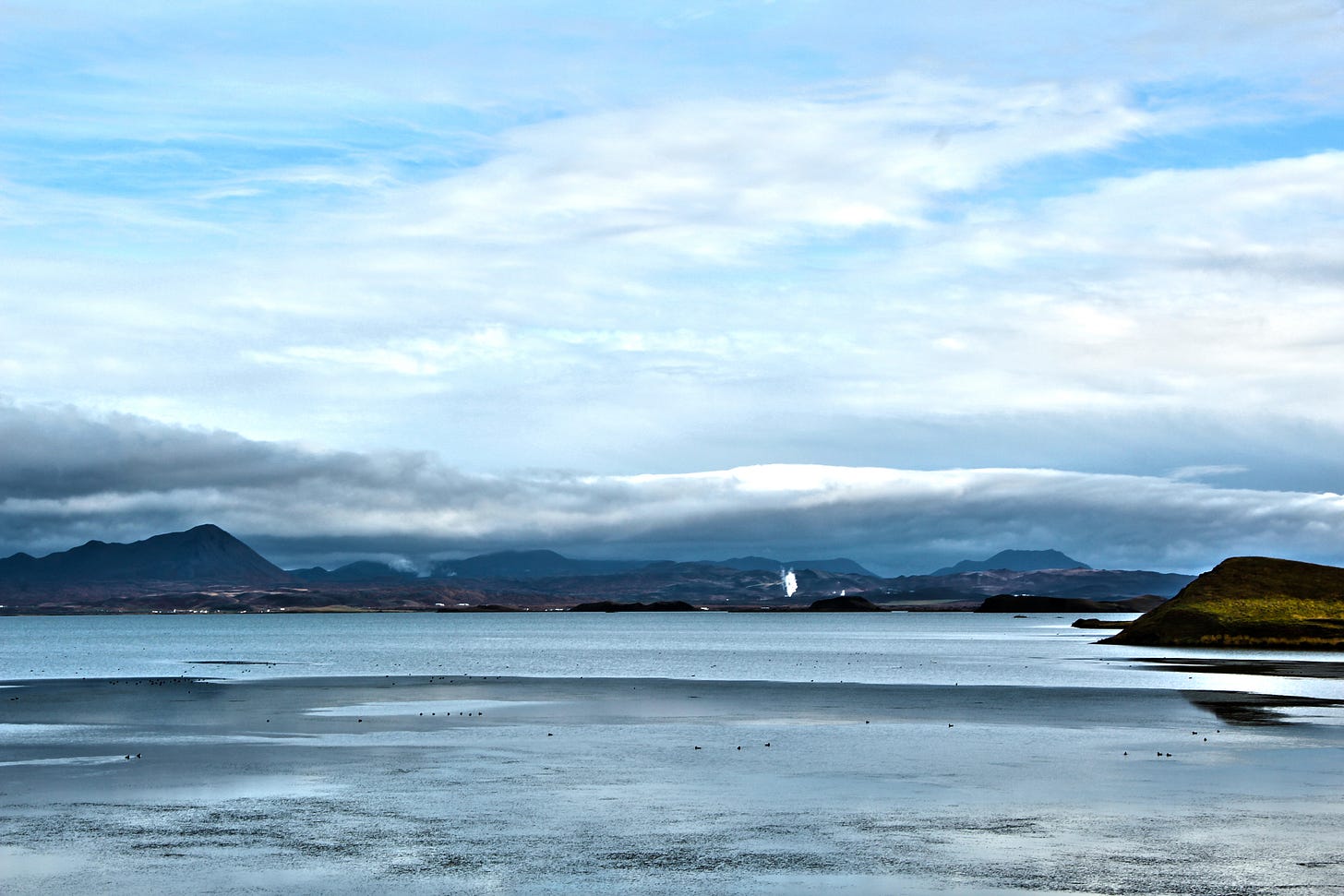Learning to Scythe
Hay making season is coming up. Another month and a half, and the grass will start turning from green to brown. That is the typical time when the local Portuguese do it, it’s not uncommon to see families working together in the little fields by the road, cutting and hauling the hay away to dry. I’ve been reading a little about hay making; the university of Georgia recommends doing the cutting when the grass is just reaching maturity. Other sources online recommend that the grass should be cut just before – or just as – the seed heads begin to form, to ensure maximal nutrition.
In my case, I definitely want the seed heads to be fully formed, because one of my main goals is to inoculate the land with as many different types of fodder as I can get. The hay field to be cut does not belong to me. There is a lady who runs a weekly play group for toddlers and young children, about forty minutes ride from here, who normally cuts her grass with a spinning chain mounted on a tractor during April. Last year, I asked if I could cut hay from a pair of her fields, and she thought it was a great idea. I could save her the effort of mowing, and her grass could grow for longer.
Regulations say that all land clearing conducted with machinery must be complete before the end of April, to reduce the risk of fire. Many of the people who now live here no longer need to make hay, or graze animals, which means that the land is becoming more of an aesthetic possession than a useful one.
That means that most of the occupied land is being cleared in April with various kinds of machinery, these land management practices do not help nature, because many varieties of wild flower and grass will not go to seed until May or June, some of the rarer varieties need even longer. Mowing grass in April significantly reduces the diversity of the seed bank.
When spring finally showed itself, I started organising the job. I would need a scythe, and some means of transporting the hay back to my place. Luckily, a Portuguese family who lives on a little farmstead further up the mountain owns two scythes that they haven’t used in years, and were happy to let me borrow them for this job. Next, I called in a favour with a carpenter who owns a big transit with a flat bed on the back, he was happy to lend his time to drive the hay between villages.
When I got the scythes, they were in need of some care. The blades were rusty and blunt. By chance, I happen to own an ovular sharpening stone, made specifically for scythes and other blades with convex curves. After ten minutes or so of working a new bevel onto the rusted blade, the first scythe was ready to cut grass. I cut some of the roadside grass as a test, the tool will take a little bit of getting used to, but I could already see the basic pattern of how to do it. If I start on the left side of the field, cutting along the margin, then the grass will pile up in a convenient straight line to dry.
I think it will be quite fun. Now I’m feeling inpatient as I wait for the grass to mature. When the job is done. My plan is to make a big hay pile on the other side of the valley, where I’m clearing away the mess that the loggers left. I want to create seven new paddocks and eight new forest zones. While there is nothing growing there except some damaged scrub, my plan is to pen the flerd into the paddocks through the summer, and feed them the hay. This way, the sheep and goat will eat their fill of the hay and spread the rest across the ground, trampling it in. That will establish a layer of carbon on the soil, offering some protection from the elements, and when the late summer rains come, the seeds will germinate, kickstarting the new paddocks into life.
This next section was written by Jackie
Often during the day, I find myself reminiscing on past adventures. Not only because I miss travelling the way I used to, it is also because people taught me some very important life lessons - only I never really knew it at that moment. In autumn of 2014, I decided to hitch-hike north, one last big trip before I left Iceland for New Zealand. First of all, hitch-hiking in Iceland was always easy, safe and a rather efficient way of getting around the island. If you got picked up by tourists, you often got to see sights along the way and if you got picked up by locals, you learnt more about the land than any Lonely Planet guide could ever teach you. I then dumped that knowledge on unsuspecting tourists on the way back, just so they could also hear which rock was a troll, which volcano did what, how much the glaciers had melted. While I was waiting in Akureyri that evening, blasted by a freezing arctic wind, I got picked up by the director of the research station in Myvatn, Árni, which was fitting because the big lake in the east of Iceland was my destination as well.
We drove through valleys east of Akureyri, heavy with volcanic haze from the Holuhraun eruption, the blueberry leaves turning a deep red on the hillsides. Even when I came back to Iceland, October in the north remained my favourite season. The colours are just incredible in the waning sun. Because it was getting cold, Árni invited me to sleep in the spare room where students would normally stay. During dinner he showed me an aquarium that held the two last living giant Kúluskítur (“shit balls”, a term that the fishermen gave the algae balls landing in their nets) or Marimo, as they’re called in Japanese. They looked like mossy footballs, the size of a lettuce head, sitting inside their glass tombs on the window sill. There are only two places in the entire world that have the right conditions for these organisms to grow to this size, a lake in Japan and Myvatn.
Once, the lake was full of them. But with agricultural run-off, a tourism industry in overdrive and no adequate sanitation facilities, increasing algae blooms starved the Marimo of sunlight, and they started dying off. These two were the last surviving members of their species. There seems to be no hope for them, except that one scientist has taken it upon himself to keep them on life support. The outlook for their survival is rather bleak, but I understand why he did it. He had no other choice.

After dark, you could see the lava of the Bárðarbunga volcano 400km away shooting up into the night sky, an ominous orange glow in the distance. I thought about how while not too far away, new earth was being born, in a violent and loud act, another piece of it was dying so quietly, only noticed by a few. I wonder if one day, I might also hold something for the last time before it goes extinct. I probably wouldn’t even know.
You see, at the time I didn’t know, but this experience really stayed with me over the years. I often think about the Marimo in the glass and wonder if they’re still alive. In hindsight, I would have asked a lot more questions about them. Living in Iceland in general made me hyperaware of just how fragile our environment is. How delicate nature can be, and most of us are completely unaware. The moss covering the lava fields of Laki, colonizing such a tiny ecological niche, but hundreds of years of growth can be destroyed in seconds if someone steps on it. How vegetation clung to the volcanic slopes, while the earth underneath my feet was still warm and smoking in places from the Eyjafjallajökull eruption in 2011. I think it was one of the motivators for me to research more into ecological restoration practices and ultimately why we do what we do here. To try our best and provide habitat to things that people don’t think about.
The New Lamb, A New Ram!
Marshmallow has arrived in the valley, bringing the total sheep population up to three. He is three months old, and filthy! He will get a hair cut when the last cold nights have faded away, then he'll have the chance to grow a clean fleece. We bought him from one of the three flocks in the nearest village to us, just down the hill and across the river. I counted twelve sheep; two rams, seven ewes, two ewe lambs, and Marshmallow.
Keep reading with a paid subscription to support our projects. Or try a free trial or free post.
Paid subsciptions include weekly updates and early access to YouTube videos.
Keep reading with a 7-day free trial
Subscribe to The Olive Branch to keep reading this post and get 7 days of free access to the full post archives.








